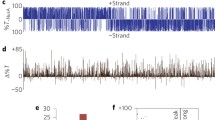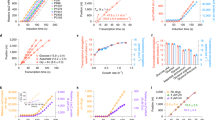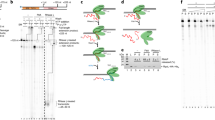Abstract
The mutations dnaG2903 and parB are both temperature-sensitive conditional lethal alleles of the Escherichia coli dnaG gene, which encodes the protein primase. The lesions are located in the 3′ end of the gene, 9 basepairs apart, and both cause Glu-to-Lys substitutions in the carboxy terminus of primase. Previously, it was shown that dnaG2903 can be suppressed by point mutations in the rho-independent transcription terminator T1, which is located just upstream of dnaG in the rpsU-dnaG-rpoD macromolecular synthesis operon. We report here that parB can also be suppressed by point mutations in T1, demonstrating that parB can be suppressed in the same manner as dnaG2903. We also identified additional suppressors of dnaG2903 that are point mutations in T1, suggesting that defective transcription termination leading to overexpression of dnaG2903 and parB suppresses the temperature-sensitive phenotype of strains harboring these mutations. Utilizing two mutant rpoB alleles whose transcription termination phenotypes at rho-independent terminators have been previously characterized, we demonstrate that defective transcription termination leading to the overexpression of dnaG does indeed suppress dnaG2903 and parB. The point mutations in T1 identified in this study were analyzed for their effects on termination efficiency at T1. Our results indicate that the thermodynamic stability of the hairpin structures may not be the sole determinant of termination efficiency in vivo.
Similar content being viewed by others
References
Burton ZF, Gross CA, Watanabe KF, Burgess RR (1983) The operon that encodes the sigma subunit of RNA polymerase also encodes ribosomal protein S21 and DNA primase in E. coli K-12. Cell 32:335–349
Cavafa Yd'A, Brady E, Thermes C (1990) Prediction of rho-independent Escherichia coli transcription terminators. A statistical Analysis of their RNA stem-loop structures. J Mol Biol 216:835–858
Cheng S-WC, Lynch EC, Leason KR, Court DL, Shapiro BA, Friedman DI (1991) Functional importance of sequence in the stem-loop of a transcription terminator. Science 254:1205–1207
Farnham PL, Platt T (1980) A model for transcription termination suggested by studies on the trp attenuator in vitro using base analogs. Cell 20:739–748
Farnham PJ, Platt T (1982) Effects of DNA base analogs on transcription termination at the tryptophan operon attenuator of Escherichia coli. Proc Natl Acad Sci USA 79:998–1002
Freier SM, Kierzek R, Jaeger JA, Sugimoto N, Caruthers MH, Neilson T, Turner DH (1986) Improved free-energy parameters for predictions of RNA duplex stability. Proc Natl Acad Sci USA 83:9373–9377
Groebe DR, Uhlenbeck OC (1988) Characterization of RNA hairpin loop stability. Nucleic Acids Res 16:11725–11735
Grompe M, Versalovic J, Koeuth T, Lupski JR (1991) Mutations in dnaG suggest coupling between DNA replication and chromosome partitioning. J Bacteriol 173:1268–1278
Jeng S-T, Gardner JF, Gumport RI (1990) Transcription termination by bacteriophage T7 RNA polymerase at rho-independent terminators. J Biol Chem 265:3823–2830
Jin DJ, Walter WA, Gross CA (1988) Characterization of the termination phenotypes of rifampicin-resistant mutants. J Mol Biol 202:245–253
Katayama T, Murakami Y, Wada C, Ohmori H, Yura T, Nagata T (1989) Genetic suppression of a dnaG mutation in Escherichia coli. J Bacteriol 171:1485–1491
Lark KG (1972) Genetic control over the initiation of the synthesis of the short deoxynucleotide chains in E. coli. Nature New Biol 240:237–240
Lupski JR, Ruiz AA, Godson GN (1984) Promotion, termination, and anti-termination in the rpsU-dnaG-rpoD macromolecular synthesis operon of E. coli K-12. Mol Gen Genet 195:391–401
Lupski JR, Smiley BL, Godson GN (1983) Regulation of the rpsU-dnaG-rpoD macromolecular synthesis operon and the initiation of DNA replication in E. coli K-12. Mol Gen Genet 189:48–57
Martin FH, Tinoco I Jr (1980) DNA-RNA hybrid duplexes containing oligo (dA:rU) sequences are exceptionally unstable and may facilitate termination of transcription. Nucleic Acids Res 8:2295–2299
McKenney B, Shimatake H, Court D, Schmeissner U, Brady C, Rosenberg M (1981) A system to study promoter and terminator signals recognized by Escherichia coli RNA polymerase. In: Chirkjian JG, Pappas TS (eds) Gene amplification and analysis. Elsevier North Holland, New York, pp 383–413
Platt T (1986) Transcrption termination and the regulation of gene expression. Annu Rev Biochem 55:339–372
Roa B, Garcia CA, Suter U, Kulpa DA, Wise CA, Mueller J, Welcher AA, Snipes GJ, Shooter EM, Patel PI, Lupski JR (1993) Charcot-Marie-Tooth disease typelA: association with a spontaneous point mutation in the PMP22 gene. New Engl J Med 329:96–101
Rosenberg M, Court D (1979) Regulatory sequences involved in the promotion and termination of RNA transcription. Annu Rev Genet 13:319–353
Ryan T, Chamberlin MJ (1983) Transcription analyses with heteroduplex trp attenuator templates indicate that the transcript stem and loop structure serves as the termination signal. J Biol Chem 258:4690–4693
Smiley BL, Lupski JR, Svec PS, McMacken R, Godson GN (1982) Sequences of the Escherichia coli dnaG primase gene and regulation of its expression. Proc Natl Acad Sci USA 79:4550–4554
van der Ende A, Baker TA, Ogawa T, Kornberg A (1985) Initiation of enzymatic replication at the origin of the Escherichia coli chromosome: primase as the sole priming enzyme. Proc Natl Acad Sci USA 82:3954–3958
Versalovic J, Koeuth T, Britton RA, Gesvain K, Lupski JR (1993) Conservation and evolution of the rpsU-dnaG-rpoD macromolecular synthesis operon in bacterial. Mol Microbiol 8:343–355
Yager TD, von Hippel PH (1987) Transcript elongation and termination in Escherichia coli. In: Neidhardt FC, Ingraham JL, Low KB, Magasanik B, Schaecter M, Umbarger HE (eds) Escherichia coli and Salmonella typhimurium: cellular and molecular biology. American Society for Microbiology, Washington DC, pp 1241–1275
Zuker M, Stiegler P (1981) Optimal computer folding of large RNA sequences using thermodynamics and auxiliary information. Nucleic Acids Res 9:133–148
Author information
Authors and Affiliations
Additional information
Communicated by M. Sekeguchi
Rights and permissions
About this article
Cite this article
Britton, R.A., Lupski, J.R. Functional analysis of mutations in the transcription terminator T1 that suppress two dnaG alleles in Escherichia coli . Molec. Gen. Genet. 246, 729–733 (1995). https://doi.org/10.1007/BF00290719
Received:
Accepted:
Issue Date:
DOI: https://doi.org/10.1007/BF00290719




